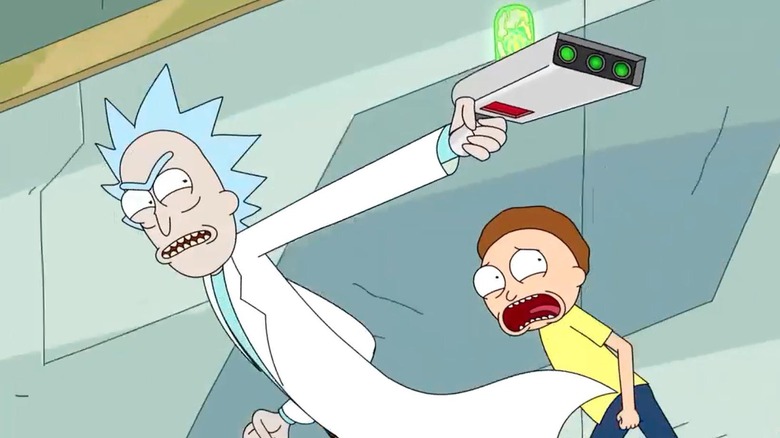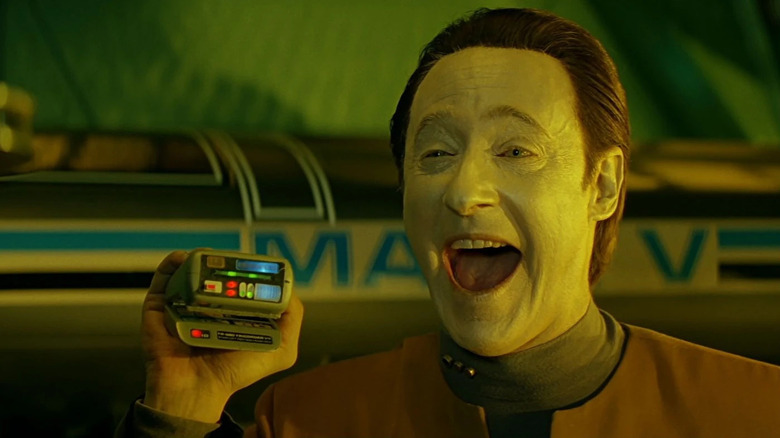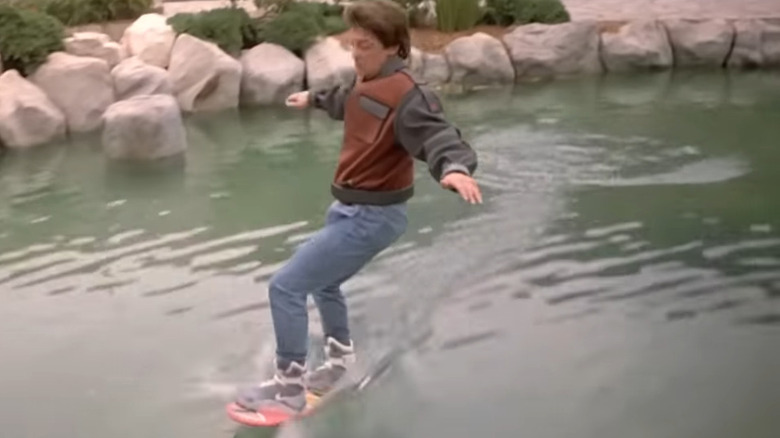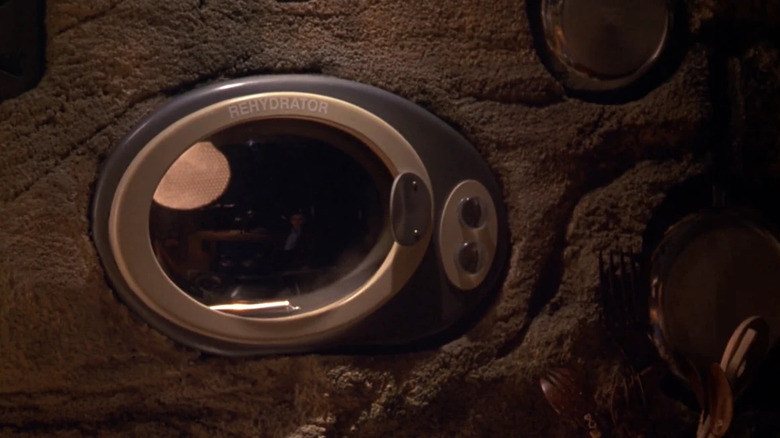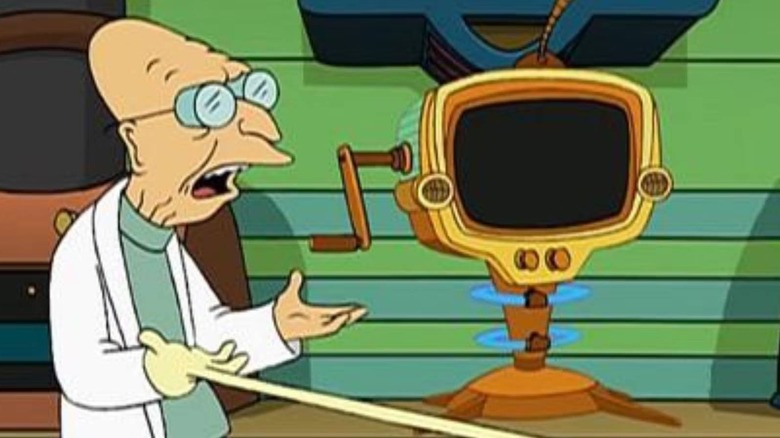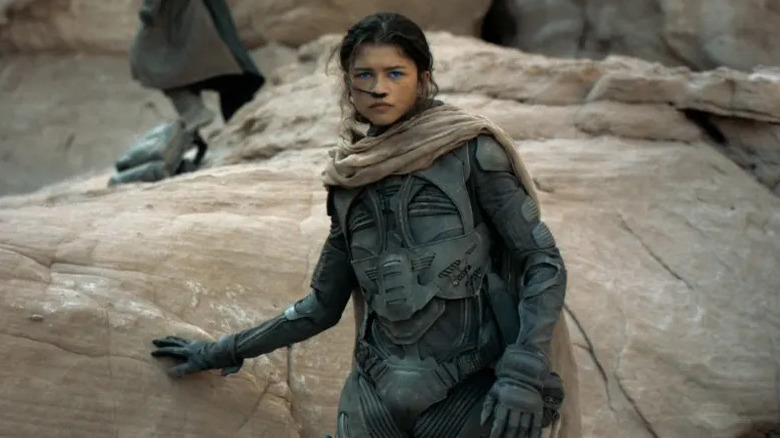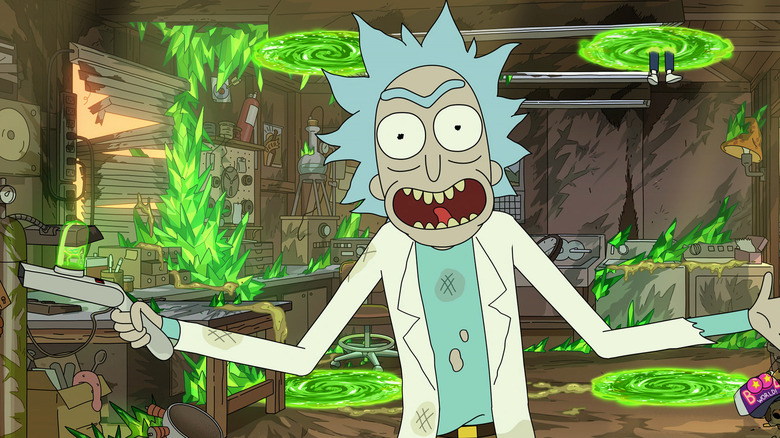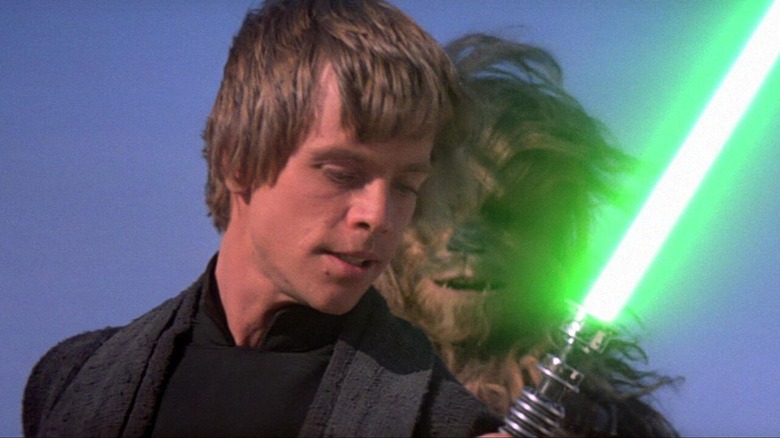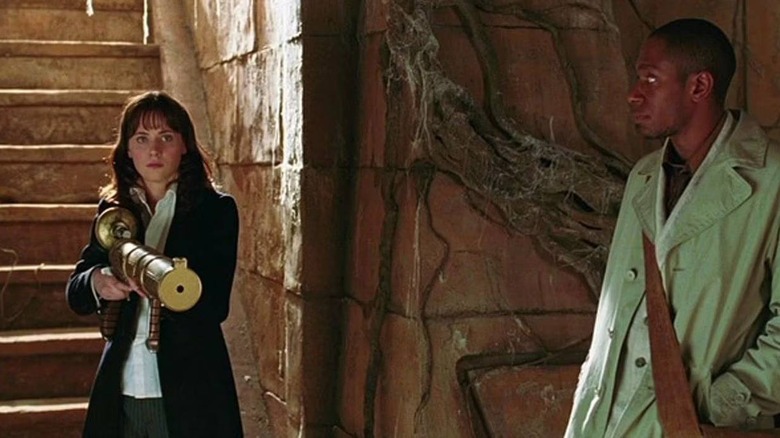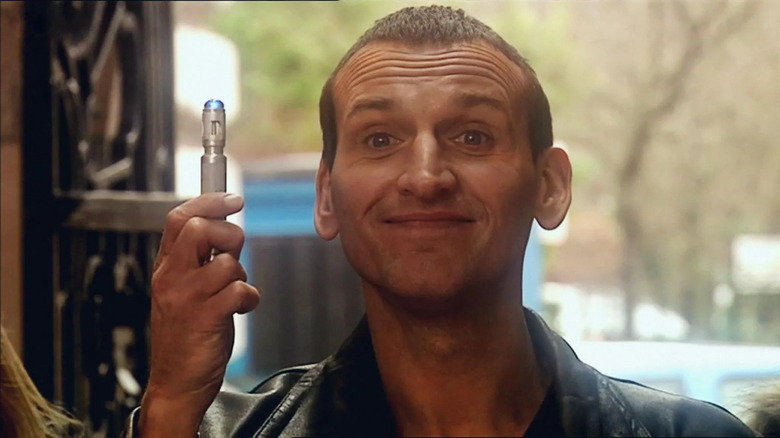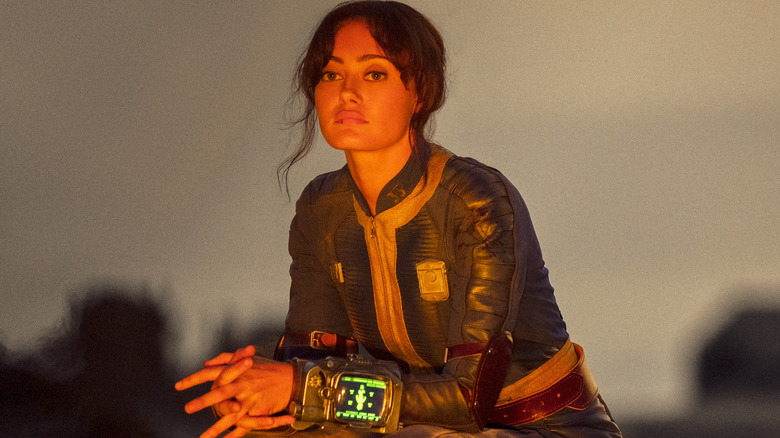10 Sci-Fi Gadgets That Would Make Life So Much Easier
Technology has expanded rapidly in the last couple of decades alone. While the inspiration for such innovation undoubtedly comes from plenty of sources, it's hard to understate the influence of science-fiction movies, books, and video games. They show us devices that could revolutionize the future, and numerous gadgets that once only existed in the realm of film and television have already come to life.
Plenty of old-school "Star Wars" tech has since become reality, including bionic body parts and holograms. "Star Trek" also predicted a lot of future technology, including long-range communication devices that could be seen as precursors to modern-day cell phones. Even those communicators weren't as advanced as the smartphones we have today, so occasionally, reality finds a way to improve upon what sci-fi writers envisioned decades ago.
Of course, there are plenty of items from science fiction that have yet to make their way into reality, largely due to how unfeasible the technology would be. But that got us thinking about what gadgets would make life here on Earth far simpler for the average person. After all, there are plenty of sci-fi tanks we wish were real, but those would have limited practical purposes for most people. And sure, there's always the possibility that someone could use these items for nefarious means, but that comes with the territory of innovation.
Tricorder from Star Trek
As we mentioned, many items that materialized on "Star Trek" eventually became a reality (or at least some version of them came to fruition). But there are plenty of other devices featured throughout the franchise that remain firmly in the reality of fiction — and they would be amazing to have. For instance, a teleporter (imagine never having to go through TSA at the airport ever again). However, when it comes to something everyone would likely use as often as their smartphones, we'd want to have the tricorder.
The tricorder is a device most Starfleet members carry around on their person to perform various tasks in the field. It's predominantly used to analyze, gather, and record a wide breadth of data, and there have been many different types of tricorders across the property's history. For example, the Psycho-tricorder is used for mental scans, which comes in handy to determine whether someone is lying. Meanwhile, a medical tricorder aids substantially in helping diagnose and treat ailments. Others exist to scan environments and acquire detailed information on living entities.
Amazingly, there is a real-life device similar to the "Star Trek" medical tricorder — the DxtER, which performs health tests and diagnoses conditions without requiring more invasive exams. Still, it'd be nice to have a complete set of tricorders to be ready for anything. "Star Trek" may have used these devices as a simple way to get exposition out of the way, but we'd definitely want a Psycho-tricorder to see if salespeople are telling the truth when they're selling a product.
Hoverboard from Back to the Future Part II
When "Back to the Future" came out, everyone wanted to drive a time-traveling DeLorean, a vehicle that's still a big deal thanks to its newest generation. Once "Back to the Future Part II" was released in 1989, everyone suddenly wanted to get their hands on a hoverboard. It's basically a skateboard that flies through the air rather than relying on wheels, and it's awesome when you need to get away from a cantankerous bully. Flying cars have long been a staple of science fiction, but the hoverboard provided a Gen X twist on the concept that seemed more manageable, even if it hasn't come to life yet.
Over the years, numerous ruses have attempted to convince the public that scientists have finally managed to create a real working hoverboard. Notably, a viral campaign tried to convince people that the HUVr board would make "Back to the Future" a reality, but none of it was true. The YouTube channel Hacksmith also kind of got a real hoverboard working in a video uploaded in January 2021. The board did catch fire, but it was capable of hovering a little bit when directly over steel, thanks to a sophisticated magnet system.
Hoverboards would be every nerd's dream come true. Instead of relying on renting scooters to get around cities, everyone could fly across the sidewalk to reach their destinations. The one in "Back to the Future Part II" even manages to go over water, so you could use it on a rainy day to avoid getting your sneakers wet.
Rehydrator from Spy Kids
Sure, "Star Trek" has the replicator, which can create virtually anything, even food. But in the interest of limiting each franchise to a single entry on this list, let's talk about the rehydrator from "Spy Kids," which is conceptually similar, at least when it comes to making tasty meals.
As shown in the movie, you just need to insert a packet into the rehydrator, which looks like a futuristic microwave. After a short time, the packet transforms into an honest-to-goodness meal, ready to eat. Carmen Cortez (Alexa PenaVega) even uses it to make herself a Big Mac meal at one point, so if it actually existed, there would be no need to get in your car for a late-night food run. You could have packets on hand to get whatever food you wanted at any time of day.
To be fair, various companies, like Barilla, have tinkered with 3D food printers, allowing people to make pasta in all sorts of fun shapes. But it just doesn't hit the same, and it takes significantly longer than the few seconds it took for Carmen to get a burger and fries. For many, the "Spy Kids" rehydrator truly exemplifies the pinnacle of what technology could be. As TikToker @diabolical.sebby posted alongside a clip from the film: "I've never wanted something more than I want The Rehydrator." The world doesn't need the terrifying Thumb Thumbs though — the movie can keep those.
What-If Machine from Futurama
Imagine knowing how a given scenario would play out before it happens. That's where the What-If machine from "Futurama" comes into play. The animated series has a couple of anthology episodes in which characters ask the machine questions about alternate realities or what would've transpired had they taken a different path. This includes Fry (Billy West) wanting to know what would happen if he was never frozen in a cryogenic tube and Bender (John DiMaggio) wondering what it would be like if he were a human.
The one downside to the What-If machine is that it can only show the outcomes of three What-If scenarios annually. This was likely chosen so that the series could only do one anthology episode per season. If such a device existed in real life, it would not only have practical implications but philosophical ones as well. More often than not, characters were worse for wear at the end of their respective stories, such as Bender getting impaled by the Empire State Building when he wanted to see what it would be like if he were 500 feet tall. If real people could see how much worse their lives might've been had they done something differently, it may help them appreciate where they are in life.
One "Futurama" megafan, Redditor u/Remoheadder, 3D-printed an actual What-If machine, but it plays "Futurama" episodes rather than giving visions of realities that never were. Honestly, a dedicated "Futurama" device would still be fine with us.
Stillsuit from Dune
The desert planet of Arrakis in "Dune" is unforgiving, so it makes sense to have an outfit that serves a practical purpose. Enter the stillsuit. This clothing captures moisture to prevent users from losing too much water while being out in the hot sun all the time. It then recycles the moisture it captures and repurposes it to be drinkable. The person drinks the water, and the cycle continues, allowing people to survive on Arrakis without dying of dehydration.
The stillsuit would be an incredible innovation for various locales on Earth that get too hot. You could wear it while you're out and about, knowing it helps you retain most of your moisture, and you'd always have a reliable water supply. You also wouldn't need to carry around one of those giant notched water jugs that tells you how much water to drink every hour.
For now, the stillsuit only exists as a fun piece of cosplay. As for the practicality of wearing the costume for filming, reviews from the cast of the most recent "Dune" movies were mixed. "Dune" costume designer Bob Morgan told Polygon about the varied responses he got: "I heard an interview with Josh Brolin and Javier Bardem. [Bardem] was saying 'Oh my God, I'm so comfortable. I loved it. I loved wearing it.' And Josh Brolin says to him, 'I don't know which one you got!'"
Portal gun from Rick and Morty
Unless science makes some serious strides in quantum physics in the near future, no one should expect the "Rick and Morty" portal gun to become a reality anytime soon. Still, there's little denying it's a crowning achievement of science-fiction travel. After all, it creates a portal that leads the user to any alternate reality. That means if someone's sad they can no longer rent movies at Blockbuster, they could visit a universe where Blockbuster never went under. With an infinite number of realities, anything's possible, from the delightfully surreal to the downright horrific.
One drawback to such a device is the possibility of severe existential angst. Access to an infinite number of universes means one might reach the same realization as Rick Sanchez (Ian Cardoni) — that everything is ultimately meaningless. No matter what happens in someone's baseline reality, there's someone else doing the exact same thing, or perhaps something slightly different. And if one grows tired of their own existence, they could always jump ship to another universe that's almost identical, which Rick and Morty (Harry Belden) have done themselves.
Jumping through various realities could get cumbersome after a while. Undoubtedly, most people would simply want to use it as a quick teleportation device in case they ever get stuck in an elevator after watching "Hulk: The Musical."
Lightsaber from Star Wars
No list of sci-fi gadgets we want to be real would be complete with the lightsaber from "Star Wars," although if brought into the real world, it would present some problems. Would we really want every single person to have a laser sword on their person at any given moment? We might need to put some regulations in place to make sure someone has the training and maturity to handle such a device. The last thing the world needs is lightsaber battles breaking out in public, no matter how cool it might be to see. One easy way to ensure only the best and brightest get their lightsabers is to have them go on a similar journey to Jedi, who must travel to the planet Ilum to attain a kyber crystal. Assuming lightsabers don't also come with vehicles capable of interstellar travel, the kyber crystals would need to be somewhere here on Earth — probably Antarctica, as it would have similar ice caves.
The best part is that lightsabers are closer to reality than ever before. Various attempts have been made over the years to produce a working lightsaber, and in 2022, Russian YouTuber Alex Burkan unveiled a genuine plasma sword that can reach temperatures of just over 5,000 degrees Fahrenheit to cut through steel. When it was first revealed, the lightsaber could only stay powered for 30 seconds when operating at maximum capacity, but it represents exceptional progress in making everyone's childhood dreams come true. Let's be honest: It's making their adult dreams come true, too.
Point of View gun from The Hitchhiker's Guide to the Galaxy
The first time the Point of View gun comes into play within "The Hitchhiker's Guide to the Galaxy" franchise is in the 2005 movie, but it's a Douglas Adams creation all the same. Robbie Stamp, executive producer of the movie, conceded to Slashdot that the device was all Adams: "All the substantive new ideas in the movie, Humma, the Point of View Gun and the 'paddle slapping sequence' on Vogsphere are brand new Douglas ideas written especially for the movie by him." It's an ingenious gadget the user can use to make their target adhere to their point of view, as commissioned by the Intergalactic Consortium of Angry Housewives.
Naturally, such power could be harmful in the wrong hands, but it would undoubtedly come in handy to resolve numerous household disputes. Arguments can have varied perspectives, with each person being a little right and a little wrong, and it wouldn't hurt to have something that would force someone to see something exactly as their partner perceives it. Granted, men are unable to use it on women in the movie due to their higher empathy levels, which renders its technology useless. As Trillian (Zooey Deschanel) states in the film, "It won't affect me. I'm already a woman."
The satire stems from women being seen as already more empathetic toward others than men. Regardless, it's always good to remember the importance of bearing in mind how vastly different other people experience the world, even outside of romantic relationships. Having a gun that makes that instantaneous would simply speed up the process.
Sonic screwdriver from Doctor Who
When it comes to "Doctor Who," there's little doubt having the TARDIS — powered by the Eye of Harmony, one of the coolest power sources in science fiction — would make life substantially easier. But when it comes to day-to-day tasks and having something that could fit in your jacket pocket, the sonic screwdriver is definitely where it's at. There have been variations on the device over the years, and it's received numerous upgrades. At its core, it's a handy-dandy gadget with a litany of uses that can help in almost any scenario.
It's useful for breaking locks, hacking computers, diagnosing medical issues, igniting gases, creating force fields, and so much more. It would likely make for a shorter list to figure out what the sonic screwdriver can't do. Hopefully, if such a device actually existed, people wouldn't have to use it to combat any Weeping Angels, but it would make numerous everyday tasks so much simpler to complete. No doubt numerous companies would jump at the chance to mass-produce the screwdrivers, especially as there have been all sorts of cool designs over the years. The Twelfth Doctor even had the sonic sunglasses model for a brief period, so people could really accessorize it to go with any outfit.
Pip-Boy from Fallout
There are all kinds of tips and tricks for getting the most out of an Apple Watch, but there's little doubt anyone who owns one would rather have a Pip-Boy attached to their wrist. Different iterations have popped up throughout "Fallout" lore, but ultimately, it's a useful device Vault Dwellers wear to monitor biometrics, manage their diets, examine inventory, listen to music, and utilize GPS. All of that comes in a sleek retro-futuristic design because even though it's the apocalypse, that doesn't mean people can't look good while venturing through the Wasteland.
Arguably, the Pip-Boy's best advantage over similar real gadgets is its durability. With an Apple Watch, you have to deal with software updates, and to be honest, it's probably not going to be too viable after just a few years. Pip-Boys have proven to remain viable several centuries after they were introduced. Even if people wouldn't rely on it in the modern age to determine how much radiation is in an area, they could still use it when they're out and about if they need a flashlight. Vault-Tec may be an evil corporation, but they sure did know how to make a gadget.
